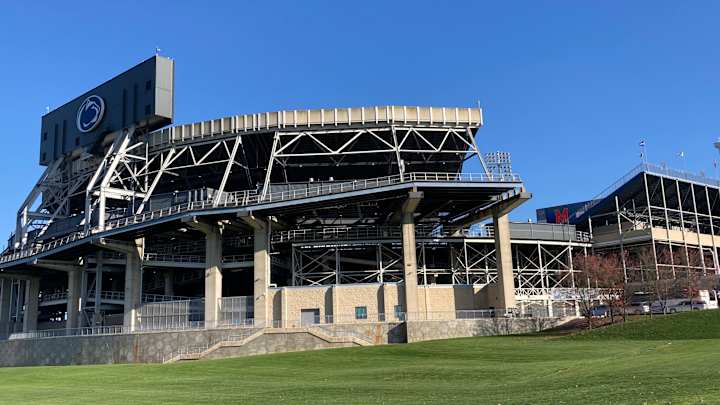What Should Penn State Do With Beaver Stadium?

Penn State continues to step cautiously into the future of Beaver Stadium, a major centerpiece of its planned 20-year overhaul of campus sports facilities.
But how large a renovation project, and how much debt, should Penn State consider investing into the nation's second-largest stadium? And would some of that money be better spent elsewhere, perhaps on athlete facilities instead?
Penn State continued to address those questions as it announced the next phase of its Beaver Stadium renovation plan. Penn State and Populous, the highly regarded architectural firm, announced in 2021 that they will partner on a concept study to review the scope of Beaver Stadium's renovation plans.
The study will evaluate current and future required maintenance projects, possible renovation options and amenity needs to support the 106,572-seat stadium. Penn State said the study is expected to last through this summer.
"Our team is looking forward to the feedback from our user groups in order to create the roadmap for the necessary and desired renovations, as well as to maximize the value that Beaver Stadium brings to our campus and community," Athletics Director Sandy Barbour said.
As part of the study, Penn State's athletic department will survey fans and community members for their input regarding long-range options for Beaver Stadium's future. In a news release, Penn State said that, through the survey, it seeks to develop recommendations about "Beaver Stadium’s near- and long-term maintenance needs, operational efficiencies, partnership opportunities as well as improvements to the fan and student-athlete experience."
The study will continue Populous's extensive work with Penn State that began with the Athletics Facilities Master Plan announced in 2017. The sweeping, 20-year project touched more than two dozen venues, created a 45,000-square-foot Center of Excellence and planned a significant refresh of the university's flagship sports venue.
Beaver Stadium reopened to fans in 2021, and the program reported a cumulative total of 747,595 ticket-holders for seven home games. That ranked No. 2 in the country behind Michigan and underscored the regenerative power of Penn State's football brand.
That's important, considering that Penn State reported a $23.9 million deficit in fiscal year 2021, which includes the COVID-impacted football season of 2020. With its revenue refreshed, and a potentially huge Big Ten media rights contract forthcoming, Penn State appears to be better positioned to embark on an enormous Beaver Stadium project than the past two years suggested.
Penn State officials have drawn parallels between their plans and the $485 million renovations Populous oversaw of Texas A&M's Kyle Field. A similarly ambitious renovation of Beaver Stadium easily would top $500 million.
Barbour called it a "massive, multiyear project" that is not close to any sort of groundbreaking. Still, is that the best use of Penn State's precious sports dollars?
So where should Penn State head now regarding Beaver Stadium? Here are some suggestions.
Maintain a capacity above 100,000
Penn State officials said in 2017 that a planned expansion would lower the stadium's capacity to about 103,000, which is fine. Officials said then that 100,000 is an "important number for us" regarding capacity, calling it a competitive advantage.
Penn State could reduce capacity easily by making more chairback seating options available (at a premium price) in the lower bowl. But Beaver Stadium shouldn't provide too much comfort, which could inhibit the atmosphere.
Basically, the more comfortable fans are, the less likely they are to stand up and make noise. Penn State's atmosphere is at its best when the crowd is standing and loud. The 2019 Whiteout game against Michigan underscored that point.
Fix what's broken
The erector set that is Beaver Stadium needs infrastructure work. Gates, ramps and concourses need to be widened to smooth fan access to their seats. Students consistently fill their sections late partly because of choked entry points and clogged walkways. And the bathrooms...
These are vital needs for Beaver Stadium that will improve the fan experience without altering the atmosphere. In fact, getting people in and out faster will enhance it.
Concessions and Wifi
Beaver Stadium needs better internet access, particularly since the athletic department has made mobile ticketing the norm. More reliable wifi will make game statistics easier to follow and help Penn State employ its in-game social media promotions more effectively.
And aside from kettle corn, Penn State's concessions mostly are forgettable. Upgrade them. Also, sell beer and wine stadium-wide. It's guaranteed revenue.
Reconsider the fancy upgrades
Penn State officials said in 2017 that planned stadium upgrades included more suites, loge boxes and club seats. These are important revenue drivers and were requested in fan surveys. And they are part of renovations coming to Wisconsin's Camp Randall Stadium this year.
But Beaver Stadium doesn't need a new facade or a dramatic physical overhaul that would add nine figures to the renovation budget. Put that money into facilities that attract athletes instead. When was the last time athlete dorms and apartments were updated?
Beaver Stadium, built in 1960 and expanded seven times since, is an iconic U.S. facility that doesn't require a total overhaul. With the needed structural updates and some nods to the future, the stadium should serve Penn State football well for decades to come.
Read more
Inside Penn State's fascinating 2020 football budget

Mark Wogenrich is the editor and publisher of Penn State on SI, the site for Nittany Lions sports on the Sports Illustrated network. He has covered Penn State sports for more than two decades across three coaching staffs, three Rose Bowls and one College Football Playoff appearance.